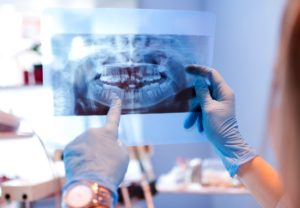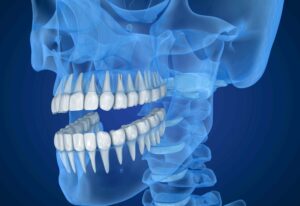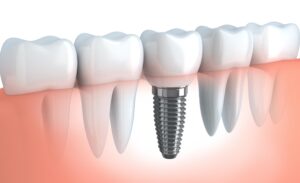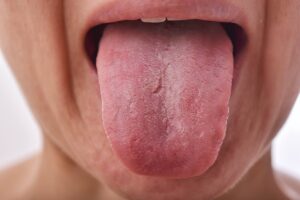Header logo
header top contact widget
Dental Technology
Six Reasons To Have Your Dental Implants Placed By A Periodontist
Posted on Jul 12, 2023 by William J. Claiborne, DDS MS
A periodontist is a dental specialist who is often in the background of various dental procedures. Yet, we are in the forefront when it comes to specialized skills that support specific treatment needs.
 Most patients are referred to our Asheville periodontal dental office by general dentists and dental specialists to provide certain aspects of dental treatment, which may involve our skills in cosmetic dentistry, dental implants, and treating all stages of gum disease.
Most patients are referred to our Asheville periodontal dental office by general dentists and dental specialists to provide certain aspects of dental treatment, which may involve our skills in cosmetic dentistry, dental implants, and treating all stages of gum disease.
A periodontist has advanced training to properly diagnose and treat all stages of periodontal (gum) disease (including gingivitis and periodontitis) as well as placement of dental implants. In addition, periodontists are particularly skilled in performing cosmetic periodontal procedures to repair gum-related disparities such as a “gummy smile” or varying gum arches that “jumble” a smile line.
A periodontist receives an additional 3 years of training after 4 years of undergraduate school and 4 years of dental school. This long, rigorous pursuit of the periodontal specialty requires the individual to be highly committed to the advanced care he or she will provide. It is our goal to help people achieve good oral health, a confident smile they love to share, and prevent tooth loss that can result from diseases of the gums.
Dental implants are now seen as the preferred option for tooth replacement. They come in over 40 different types designed to accommodate various challenges and preferences. But, why should you have your dental implants chosen and placed by a periodontist? After all, some dentists perform this in addition to their general dentistry services.
Below are 6 reasons our dental implant patients have particular advantages…
(1). With specialized skills, a periodontist is especially respectful to oral tissues as sensitive layers that have an important role in the appearance of a smile and the health of teeth. Utilizing these skills, a periodontist can help to minimize incisions while effectively treating each area in the mouth.
(2). Rather than be limited to just one or two dental implant systems that were taught in a “crash course” by the implant manufacturers, our speciality understands the complete spectrum of implant systems. Some may be ideal for your needs while others may not. Some provide you with a non-removable (“fixed”) option while others may involve removable teeth. Our specialized skills give you the best choices you should have.
(3). Additionally, the proper selection of your dental implants may greatly save you in treatment fees. For example, the All-On-4 dental implant system needs only 4 implants per arch, and can be placed in shallow bone. The treatment fees are less since the number of implants is low and the need for bone regeneration for severe bone loss may not be required. For these reasons, a periodontist may be able to help you achieve your tooth replacement goals within a budget you can manage.
(4). In our Western NC periodontal dental office, our advanced technology includes 3-D Cone Beam Imaging. This is ideal for diagnoses and treatment planning through images that provide a clear view of the upper and lower jaw (including nerve canals), with rotations that show sagittal, axial, and coronal planes. The imaging process is quick, painless and at minimal radiation levels.
(5). Another feature is our Computerized Dental Implant Placement system. This advanced technology is designed for pre-surgical positioning of dental implants that uses a 3D model of the patient’s jaw. Once the implant type is selected, a template is developed for optimal treatment success, even for complex cases. This minimizes disruption of gum tissues and targets implant placement at ideal depths and angles. Thus, treatment success rates are higher with faster (and more comfortable) healing time.
(6). Optimal comfort for our patients has always been a priority. For many, a desired level of comfort and relaxation includes sedation options. Here, we offer several sedation options, including oral and IV sedation.
Oral sedation is a pill that helps patients relax. It also has an amnesiac effect, leaving most with little or no memory of treatment afterward. IV sedation (also known as “twilight sleep”) places the patient in a deeper sleep state and erases memory of the procedure. It is administered by a Medical Doctor (MD) who is a board certified Anesthesiologist.
With both sedation options, patients are closely monitored with advanced safety equipment throughout treatment.
If you are considering dental implants, you may wish to begin with a consultation appointment. During this time, we can explain the vast difference in comfort, treatment time, and success available through our specialized skills and extensive technology.
Call 828-274-9440 to schedule. New patients are always welcome and a referral is not always required.
AI in Dentistry – A Good Thing.
Posted on Jul 05, 2023 by William J. Claiborne, DDS MS
I remember when microwave ovens first appeared on the market. My mom wouldn’t even go near one in operation. Now, we know how to use them and the good things that come from their use.
Shoot forward 50 years and, like it or not, AI (artificial intelligence) is here. Self driving cars and round vacuums that move along floors are no longer Jetson-like imaginings. They’re blending into our lives in ways that are beneficial and non-threatening.
Like the microwave oven easing its way into day-to-day living, it’s logical that some people fear AI as a bad thing. After all, movies made decades ago prompted a vision of robots meandering among the human race as a new, threatening species.
As an Asheville periodontist, I’ve already seen – and incorporated in use – the positive aspects of breakthrough technology. Understanding its detection capabilities and accuracy, I’m particularly excited about the potential AI brings to the medical and dental fields.
You may be surprised to know that dentists are already beginning to turn to AI technology to quickly and accurately detect and prevent periodontitis, decay, bone loss and other gum health issues.
For example, a medical technology company in Boston has developed an AI platform that can assess X-ray images to an extent of over 50 times what can be detected by dentists through visual reviews. This allows dentists to give more effective treatment recommendations for patients while supporting the potential to avoid (or minimize) existing problems from developing or worsening.
For patients, AI assessments can also be reassuring. For those who anticipate particular treatment needs – a root canal, for instance – these assessments can zero in on exact issues so treatment planning is as conservative and as minimal possible, while being fully effective for the particular need.
Not just in medical and dental offices, but we’ll likely see AI used mainstream in many sectors. It can optimize accuracy in organizational materials, financial and budget projections, construction, farming, etc. For those of us in the periodontal dental field, AI has a vast potential to greatly improve the oral – and overall – health of our population.
Gum disease affects over 47% of American adults. With the help of AI, we can identify a higher percentage of cavities in earliest development stages while cutting the rate of misdiagnosis in half (thus curtailing over-treatment, in some cases). AI analysis will also aid in early detection of abscesses, lesions and oral diseases. It can prove to be a remarkable asset in catching oral cancer, helping to increase its poor survival rate or minimize the severity of treatment.
Through decades of research and extensive studies, keeping good oral health has been shown to be a supporting factor in good overall health. By keeping the “bad” bacteria in the mouth to manageable levels, the immune system operates more efficiently. Too, risk of medical complications from diabetes, heart disease and other illnesses can be significantly decreased.
It is suspected that many people are unaware that they even have periodontal (gum) disease, mainly because gum disease often begins with no obvious symptoms of its presence. Then, once symptoms appear (such as seeing blood in the sink when brushing), people may shrug this off as normal, or merely a sign they are being thorough in their brushing technique.
Gum disease is a particular problem for our aging population. The normal aging process dries out our hair, skin, and yes, the mouth. When the mouth is dry and saliva flow is insufficient, bacteria accumulation is more likely. This, in turn, provides a more welcoming environment for bacteria growth.
Too, many medications on the market – both prescription and OTC – have a side effect or oral dryness. This is double trouble for seniors, who already have “dry mouth” to combat. However, for people who smoke and/or are consumers of caffeine, they fall into this risk group as well.
Caffeine is present in coffee, tea, most colas, and (darn!) even chocolate. It can be in high concentrations in things like energy drinks and “power” bars. Caffeine-fortified foods can surprisingly include marshmallows, some cereals (and breakfast bars), jelly beans, gummy bears and frozen waffles.
Although AI will be an added perk to diagnosing oral health problems, it is the dentist and the patient together who have much more important roles. While regular dental check-ups help to remove existing buildup on teeth (known as plaque, which can harden into tartar), at-home care is what helps to prevent problems between visits.
It is first important to know the signs and symptoms of the various stages of gum disease. Warning signs include:
• Red, swollen, or tender gums or other pain in your mouth
• Bleeding while brushing, flossing, or eating hard food
• Gums that recede or pull away from the base of teeth
• Loose or separating teeth
• Pockets of pus between gums and teeth
• Sores in the mouth
• Persistent bad breath
• A change in the way your teeth fit together when you bite
• A change in the fit of partial dentures
The dentist-patient relationship can never be replaced by AI. Once you find a dental office where you feel respected, comfortable, and have total confidence, technology itself is merely an add-on.
If you have not had regular dental care or feel you have symptoms of gum disease (as listed above), it is recommended that you renew your commitment to your smile and your overall health with a complete periodontal dental examination.
During this time, your periodontist will note any areas that are diseased or at risk of developing such. He or she will explain recommended treatment and discuss a comfortable pace for your individual needs. Payment plans can also be discussed after determining the type of treatment most appropriate for your care.
If dental fear or anxiety has kept you from regular dental care, our NW Carolina periodontal dental office has a reputation for helping adults overcome the obstacles it can pose. Please share your concerns prior to or during your examination appointment. We offer several comfort options (in addition to our reputation for a gentle touch) and can explain what may be best for your care. We offer oral and IV sedation (twilight sleep), which are administered safely and with advanced monitoring equipment.
Too, our vast array of advanced technology often helps to minimize treatment while optimizing comfort. Please learn more about these features at: BiltmorePerio-Technology
We can’t stop progress, nor should we resist it. While most anything can be used with ill-will, I see AI in dentistry as a positive part of providing exceptional oral health to our patients – and our adult population!
But first, we must get you into the office. And that’s your decision. We don’t have technology to coax you in and hope you will take that step on your own before problems force you into a dental chair (which is often the case, unfortunately).
Call 828-274-9440 for an appointment or to have your initial questions answered.
Sources:
https://www.perio.org/for-patients/gum-disease-information/
Avoid An Aged Appearance By Keeping Facial Bone Structures Healthy
Posted on Jun 21, 2023 by William J. Claiborne, DDS MS
The aging process can, unfortunately, take quite a toll on appearance. Shoulders may slump, waistlines may widen, and hair may turn gray. As a periodontist in Western NC, I see another telltale sign of aging – resorption. This is the process of bone loss when natural tooth roots are missing from the jaw bones. Facial features affected by resorption can reveal quite a lot, and not in a flattering light.
A natural tooth is held by the upper or lower jaw bone by its roots. Around the base of each tooth, gum tissues wrap snugly to prevent entry of bacteria and protect sensitive tooth roots. These roots help to keep the tooth ‘alive’ by supplying blood and other nutrients to the bone supporting the tooth. Through the presence of these roots, the jaw bones also receive valuable stimulation, which helps the bone retain its mass.
Losing a tooth can trigger a domino effect, of sorts. Statistics show that tooth loss is most likely to occur in an area next to that of a missing tooth. Without the stimulation of tooth roots, the bone in that area will begin to resorb, or shrink in mass. This increases risks for adjacent teeth.
The process of resorption begins slowly the first year. However, the rate of bone loss accelerates more and more each year. For people who wear a denture or partial, the pressure of wearing these appliances can speed up the rate bone loss even more. Eventually, facial features change due to the declining bone structure, changes that tend to age one’s appearance far beyond their actual age.
Initially, the changes may be subtle, such as deep wrinkles around the mouth. The corners of the mouth begin to turn downward, even when smiling. Jowls form as facial muscles detach from shrinking bone structures. As the bone declines further, the chin becomes more pointed and the mouth seems to collapse into the face. The chin moves closer to the nose, creating what’s referred to as a ‘granny look.’
Dental function also takes a hit when it comes to tooth loss. The strength of the bite becomes challenged. Jaw bone breaks are more likely. Wearing a denture or partial becomes challenging due to its declining ‘ridge’ that is relied upon for support. Dental prosthetics begin to slip while eating, or even speaking. Eventually, frequent applications of denture pastes and adhesives are needed. After a time, even relines help very little.
As a periodontal specialist, one of my advanced skills (in addition to the treatment of all stages of gum disease) is in the diagnosis and placement of dental implants. For adults who are missing one or more natural teeth, we recommend dental implants for a number of reasons.
Why should you have your dental implants placed by a periodontist?
There are over 40 different implant systems, each designed to accommodate various needs and goals. For example, one consideration in determining the type of dental implant is in the assessment of jaw bone mass.
An implant needs a particular amount of bone structure to support it. After several years of missing tooth roots, the amount of existing bone may eliminate some types of dental implants or indicate the need for additional procedures prior to placement.

With adequate bone mass to support the implant(s), the choice of implant can be made based upon your needs and preferences. Without the necessary bone mass, we may advise a bone rebuilding process prior to implant placement. Typically, this does not require a bone graft. In many cases, we are able to apply a bone rebuilding material that regenerates ample bone mass. Or, we may advise an implant system that uses unique implant lengths and placement angles (the “All-On-4”) that can function dependably in minimal bone.
The benefits of dental implants are many. These include:
A lifetime solution – When properly selected and placed, dental implants are designed to last a lifetime. This is why a periodontist is an ideal choice for your selection and placement.
A healthy choice for remaining teeth – Although each natural tooth seems to “stand alone”, individually, they provide support for the teeth on each side and the one above or below. This helps to keep teeth in their proper positions. However, dental implants provide stimulation to the bone to help retain bone mass. And, teeth supported by implants do not rely on the support of crowned (or ‘capped’) teeth on both sides. Thus, preserving the integrity of adjacent teeth.
Restoring biting and chewing stability – Because dental implants are anchored by the jaw bone, biting and chewing stability is restored. People who have dental implants are able to eat healthy, fibrous, and chewy foods once avoided due to ill-fitting dentures or partials.
The feel of your “own teeth” – Rather than have clunky dental prosthetics in your mouth, dental implants act like your own teeth. You can brush them in your mouth and eat foods you love and laugh with friends. Unlike dentures or partials, no more sore spots rubbed on tender gum tissues and no more piercing seeds caught between the gums and denture base.
A wise investment – Dental implants, unlike crown-&-bridge, dentures or partials, will not break, develop a cavity, require periodic “relines,” or need a root canal. Made of titanium, an implant will last your lifetime without requiring the upkeep of other types of restorative options.
In our Asheville periodontal dental office, we offer some of the most advanced dental technology available. This allows our patients to enjoy optimal comfort with minimal treatment time. We are also committed to patient comfort through oral and I.V. sedation (“twilight sleep”). These are administered safely with continual monitoring by trained team members.
If you are considering dental implants to replace missing teeth, begin with a consultation appointment. This will take place in a private room where we can discuss your needs and concerns. Call 828-274-9440 to schedule, or tap here for contact information.
Safe Tips for Cancer Patients To Protect Oral Health During Treatment
Posted on Jun 09, 2023 by William J. Claiborne, DDS MS
Cancer has touched so many in the U.S. It is a major, if not deadly, challenge for not just the cancer patient. The each individual diagnosed, it can also impact the lives of spouses, children, family members, and friends.
The progress in improving the rates of cancer survival in America are, fortunately moving in the right direction. As of January 2022, the National Cancer Institute shares that there are an estimated 18.1 million cancer survivors in the United States, representing approximately 5.4% of the population.
By 2032, the number of cancer survivors is projected to increase by 24.4% and by 2040, it is projected to grow to 26.0 million.
As progress continues, treatment for cancer remains a daunting ordeal. The long treatment time and extreme side effects associated with cancer treatment is seen as simply awful. The oncology teams that surround these patients are amazing, however, and try to lessen the burden throughout.
As a periodontist, I am familiar with the oral side effects of chemotherapy and radiation. I am very dedicated to these patients, and strive to help them be comfortable while protecting their oral health.
What’s important is to care for oral health in a way that keeps the patient comfortable while helping them to avoid any after-effects. This is where I differ with some advice for cancer patients since not all “tips” are good for the teeth and gums. For example, cancer patients undergoing chemotherapy may be advised to suck on on peppermint or lemon drops to relieve dry mouth. Not so fast…
Caring for oral health during any health condition that lowers the immune system can actually support your immune system by lowering systemic inflammation. Research has linked many health problems, including some cancers, to the bacteria of advanced gum disease (periodontitis).
Information shared by the American Academy of Periodontology states:
“Researchers found that men with gum disease were 49% more likely to develop kidney cancer, 54% more likely to develop pancreatic cancer, and 30% more likely to develop blood cancers.”
Oral dryness causes the tissues in the mouth to become inflamed, which places you at greater risk for infection. Insufficient saliva flow ups your risk for tooth decay and gum disease. So, it’s understandable that sucking on candy may help. However, the sugar from this candy that lingers in the mouth for long periods creates a higher risk of gum disease and the demineralization of tooth surfaces, opening the door for cavities.
One article in RDH Magazine shares these cautions for cancer patients:
• Products with drying and potentially irritating ingredients, like sodium lauryl sulfate, can increase risks for oral mucositis (the soft tissues in the mouth).
• Strong flavors can feel too sharp for tender tissue and can increase nausea.
• Inappropriate selection of toothbrush head sizes and bristles makes plaque removal more difficult and tissue trauma is more likely to occur. This may affect the patient’s ability to brush at all.
• Sugary and/or acidic products such as hard candies can increase risks for caries, erosion, and infection.
• Petroleum-based lip balms ultimately keep lips drier and create a dense barrier that can trap bacteria and impurities against the skin, which increases infection risks.
While chemotherapy is known to cause nausea, another common complaint of patients undergoing chemotherapy or radiation is having a metallic taste in the mouth. Just as certain components of oral medications can emerge in saliva, drugs administered intravenously can also emerge in the saliva, causing “metal mouth.”
However, it’s important to note that women who are menopausal or post-menopausal may experience changes in their mouths. They may experience dry mouth, pain and burning sensations in the gum tissue as well as altered taste, especially salty, peppery or sour.
In addition to chemotherapy, “dry mouth” is a common side effect of many medications, including prescriptive and over-the-counter. These include antihistamines, decongestants, painkillers, high blood pressure medications, anti-depressants, muscle relaxants, drugs for urinary incontinence and many others. Some medications, along with chemotherapy, can result in oral sores or spots of discoloration.
Because some spots and discolorations can be symptoms of oral cancer, keeping your dentist aware that you take these drugs helps he or she to monitor these areas closely and appropriately. However, other medications can cause sores in the mouth, inflammation or discoloration of gum tissues. These include those taken for blood pressure and oral contraceptives.
For some cancer patients, our dental laser is an option that can speed healing of these sores and restore comfort faster. Additionally, our Asheville periodontal dental office features advanced technology that often minimizes treatment and enhances patient comfort.
For those who take medications that help to strengthen bones, these have been associated with a rare but serious condition called osteonecrosis of the jaw, known as “death of the bone.” These medications, prescribed to help prevent or treat osteoporosis with certain versions administered by injection.
Osteonecrosis of the jaw commonly occurs after certain dental procedures such as extractions or implant placement. About 90% of those who have experienced osteonecrosis are those who took the medication in repeated high doses due to cancer or other diseases. However, 10% who experienced osteonecrosis were taking much lower doses, mostly intended to treat osteoporosis. Those who currently take these medications or have taken them within the past year should reveal this to their general dentist or dental specialist prior to any procedures – including a cleaning.
Periodontal (gum) disease, teeth with cavities or the loss of natural teeth can negatively affect physical, emotional, and financial quality of life. In addition to treating existing problems, our Western Carolina periodontal office is structured so our patients can avoid long-term damage to oral health. We are known for making patient comfort a priority – at every visit.
For an examination, call 828-274-9440. Or, ask to begin with a consultation.
Sources:
https://www.perio.org/for-patients/gum-disease-information/gum-disease-and-other-diseases/
Recent Posts
Categories
Archives
- September 2024
- August 2024
- July 2024
- June 2024
- May 2024
- April 2024
- March 2024
- February 2024
- January 2024
- December 2023
- November 2023
- October 2023
- September 2023
- August 2023
- July 2023
- June 2023
- May 2023
- April 2023
- March 2023
- February 2023
- January 2023
- December 2022
- November 2022
- October 2022
- September 2022
- August 2022
- July 2022
- June 2022
- May 2022
- April 2022
- March 2022
- February 2022
- January 2022
- December 2021
- November 2021
- October 2021
- September 2021
- August 2021
- July 2021
- June 2021
- May 2021
- April 2021
- March 2021
- February 2021
- January 2021
- December 2020
- November 2020
- October 2020
- September 2020
- August 2020
- July 2020
- June 2020
- May 2020
- April 2020
- March 2020
- February 2020
- January 2020
- December 2019
- November 2019
- October 2019
- September 2019
- August 2019
- July 2019
- June 2019
- May 2019
- April 2019
- March 2019
- February 2019
- January 2019
- December 2018
- November 2018
- October 2018
- September 2018
- August 2018
- July 2018
- June 2018
- May 2018
- April 2018
- March 2018
- February 2018
- January 2018
- December 2017
- November 2017
- October 2017
- September 2017
- August 2017
- July 2017
- June 2017
- May 2017
- April 2017
- March 2017
- February 2017
- January 2017
- December 2016
- November 2016
- October 2016
- September 2016
- August 2016
- July 2016
- June 2016
- May 2016
- April 2016
- March 2016
- February 2016
- January 2016
- December 2015
- November 2015
- October 2015
- September 2015
- August 2015
- July 2015
- June 2015
- May 2015
- April 2015
- March 2015
- February 2015
- January 2015
- December 2014
- November 2014
- October 2014
- September 2014
- August 2014
- July 2014
- June 2014
- May 2014
- April 2014
- March 2014
- February 2014
- January 2014
- December 2013
- November 2013
- October 2013
- September 2013
- August 2013
- July 2013
- June 2013
- May 2013
- April 2013
- March 2013
- February 2013
- January 2013
- December 2012
- November 2012
- October 2012
- September 2012
- August 2012
- July 2012
- June 2012


